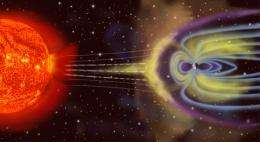April 19, 2012 report
Space environmentalist warns we need to better prepare for solar storms

(Phys.org) -- In the business of everyday life, it’s easy to overlook things that could cause a serious disruption to how life is lived; floods happen, hurricanes, volcanoes and tsunamis like the one that devastated Japan last year. And now it seems, there is one more potential disaster we should add to the list: geomagnetic storms caused by coronal mass ejections from the sun. Mike Hapgood head of the space environment group with RAL Space, part of the UK Science and Technology Facilities Council, has written a commentary published in the journal Nature, suggesting that it’s time we quit burying our heads in the sand regarding the devastating impact a serious solar storm could have on modern populations.
The problem he points out, is that we’ve become so dependent on electricity and electronic communications, that a big solar storm could cause power grids the world over to go down, and for GPS to become non-functional for an unknown amount of time, causing havoc across a wide spectrum of systems such as those used by the military, the Internet, financial institutions and of course aviation. And what’s more, he says, it doesn’t necessarily have to be that way because there are many things that could be done to prevent such a nasty outcome.
He suggests, for example, that power grids could be upgraded to better withstand such an onslaught. He cites how upgrades were made to many grids the world over after a solar storm in 1989 knocked out power to a large section of Quebec. Unfortunately, that storm was rather puny compared to other storms that have hit Earth. One in 1921 was bigger, and another in 1859 was so powerful that it caused telegraph machines to set fire to cable offices. A storm today of that magnitude could cause power outages lasting in some places for months. Upgrading transformers even more, he says, could prevent such an outcome.
But then the question is, how far do you go? Since no one really knows how bad solar storms can get, no one really knows how much protection to build into systems. Because of that, Hapgood says we need to do our homework. There are records, he points out, of prior events and what occurred as a result, but they are all mostly hand written and stored in unknown locations. We need to find those, digitize them and make them available to researchers.
We need to get better at forecasting too, he adds. Currently we get from ten minutes to about an hour’s notice for solar storms, very little time to take preventive action. Better satellites could be built and put into space that could open that window a little wider, perhaps giving grid operators or those that run satellites enough time to take evasive action that could save such facilities from damage.
In summation, he writes, we as a world community need to take the possibility of a serious solar storm more seriously and then start doing things to minimize the damage that could result. Failure to do so could lead to widespread chaos and unknown circumstances thereafter.
More information: Astrophysics: Prepare for the coming space weather storm, Nature 484, 311–313 (19 April 2012) doi:10.1038/484311a
Journal information: Nature
© 2012 Phys.Org














